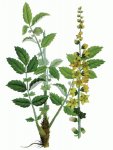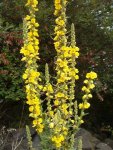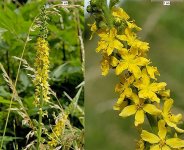Caddis flies
Agrimonia eupatoria L.
Botanical characteristics. Family rose-colored. Perennial herbaceous plant with a harsh-haired, upright stalk, 80-100 cm high. Rhizome thick, short. Leaves are dark green intermittent. Golden-yellow flowers are collected in spicate inflorescences on the tips of the stems. Blossoms in June-July, fructifies in July-August.
Spread. It grows in the hills, on the fringes, among the bushes, along the roads. It occurs quite widely in the middle belt of the European part of the country, in Central Asia, in Western Siberia and the Caucasus.
Used parts of the plant.
Grass during flowering.
The plant is poorly understood. It found bitterness, glycosides, tannins, essential oil, mineral salts, pectic acid (in a small amount), B vitamins, steroid saponins, flavonoids and alkaloids.
Application.
In scientific medicine is not used. It is used mainly in diseases of the liver and bile ducts: with hepatitis, cholecystitis, cholangitis, postcholecystectomy syndrome, pancreatitis; Especially recommended for cholelithiasis, as it promotes the dissolution of stones and sand in the gallbladder. The crayfish acts reluctantly on the intestines, intensifies diuresis, reduces inflammation of the joints with rheumatism and rheumatoid arthritis, acts as a hemostatic for various bleedings.
Infusion of herbs is recommended as well as spasmolytic in neurocirculatory dystonia, accompanied by migraines and sympathetic-adrenal crises.
Oternally, the rash in the form of rinsing and lotions is prescribed for angina, pharyngitis, stomatitis and for various tumors and hardens.
Preparation. 2-3 tablespoons of herbs are insisted in a half-liter thermos - a daily dose. For external use, the dose of vegetable raw materials is doubled.





Comments
When commenting on, remember that the content and tone of your message can hurt the feelings of real people, show respect and tolerance to your interlocutors even if you do not share their opinion, your behavior in the conditions of freedom of expression and anonymity provided by the Internet, changes Not only virtual, but also the real world. All comments are hidden from the index, spam is controlled.